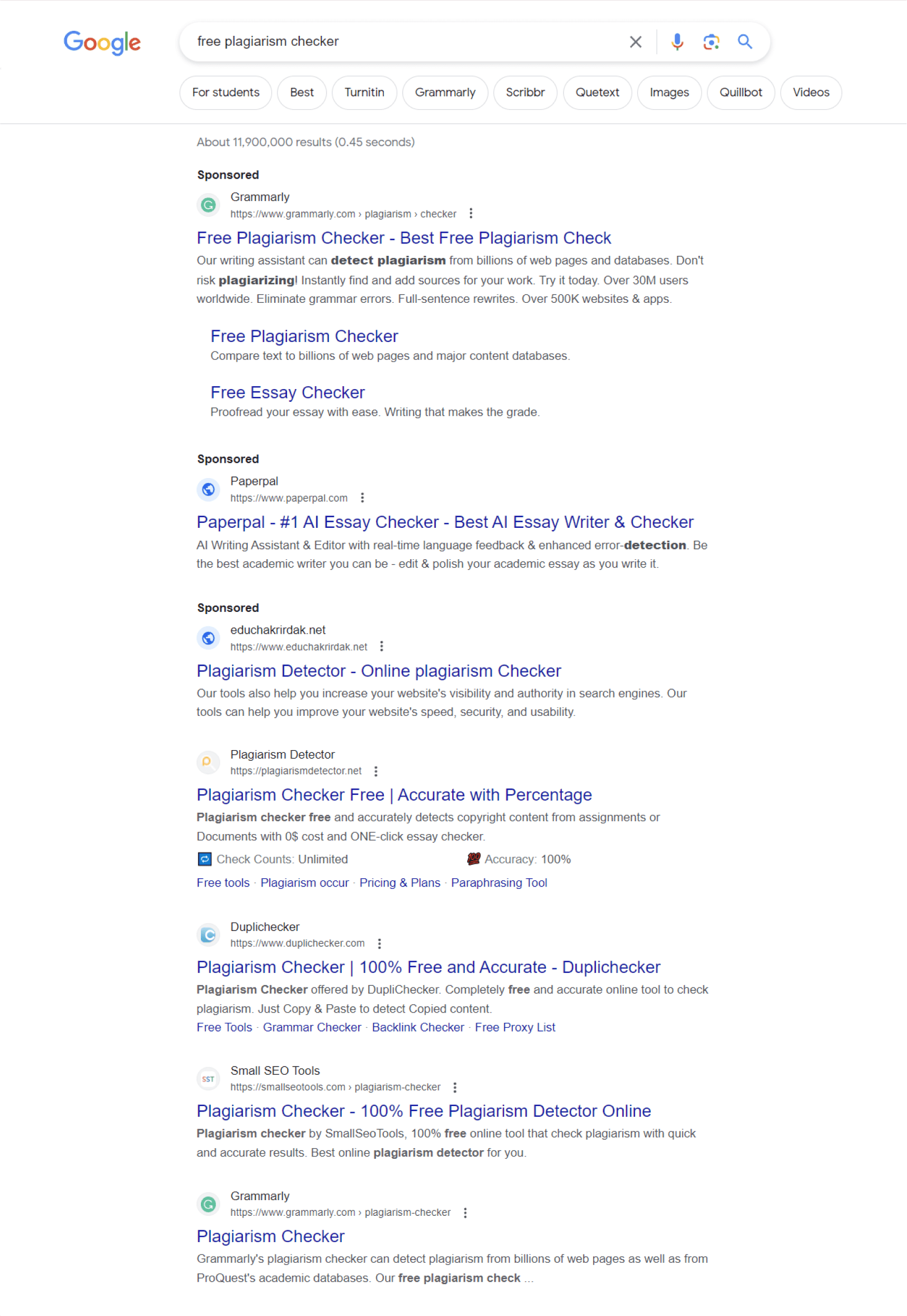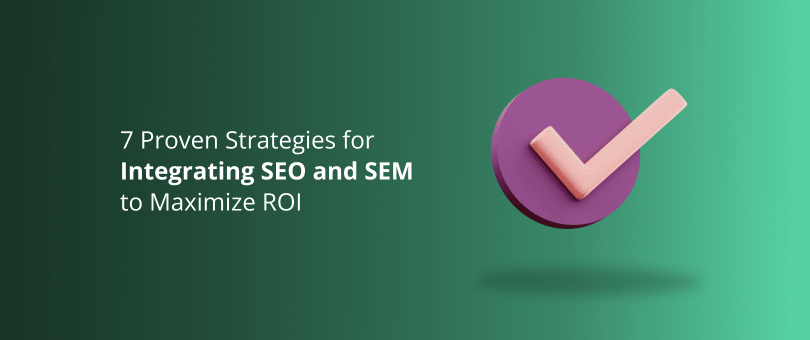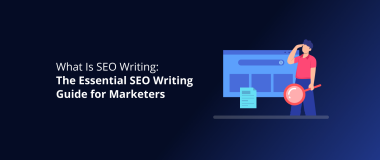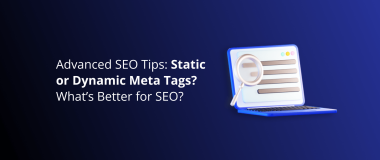Marketers and business owners striving to enhance their online presence often question which approach offers the best results and return on investment – SEO or SEM? What if the ideal solution involves both? In this article, we’ll explore how to construct an effective digital marketing strategy that harnesses the potential of both organic and paid promotions. Read on to discover how to outpace your competition and elevate your ROI!
SEO and SEM strategy: What about ROI?
The primary aim of any marketing strategy, including SEO and SEM, is to achieve as high a Return on Investment (ROI) as possible. It measures the profitability of an investment and is critical in assessing the effectiveness of your marketing efforts. Usually, it is calculated as follows:

For instance, if a marketing campaign costs $200 and leads to a sales growth of $2,500, the ROI would be 1150%:
($2500 – $200) / $200) = 1150%
When it comes to this point, SEO tactics are usually a more cost-effective measure.
They are even lauded for delivering one of the highest ROIs in marketing. This is because it doesn’t require a substantial monetary investment to yield significant sales. Even if your company has temporarily cut back on its marketing budget, it can still reap the rewards of its SEO investment if your pages are well-ranked.
Monitoring the effectiveness of your SEO strategy is vital and requires tracking your website’s performance over time. For this purpose, you can do the Google keyword ranking check with a Rank Tracker Tool by SE Ranking, which helps monitor keyword rankings on a regular basis. The tool offers insights into keyword ranking, target URLs to spot cannibalization issues quickly, SERP features, search volume, traffic forecast, and more. It helps SEOs and online marketers to make data-driven decisions and adjust their strategies in a timely manner.
What about SEM? Well, it allows for more immediate results and direct measurability, making ROI calculations straightforward. However, you stop generating new sales when you turn off the ad.
Ultimately, a well-balanced mix of both strategies can optimize your overall ROI. And that’s what we’ll talk about in the next part of this article.
How Can You Make SEO and PPC Work Together?

1. Dominate the SERP
Would you deactivate your paid search marketing campaigns once your website achieved high organic rankings? We wouldn’t recommend it.
Many marketers wrongly assume that SERP ads are unnecessary if their site ranks high in the organic SERP results, as they target exact searches. They believe it makes no difference whether users click on an organic or paid link.
However, research indicates that discontinuing PPC ads can decrease SEO performance. Moreover, having two links in the SERP instead of one (organic and paid) increases the likelihood of users being redirected to your site rather than your competitors.
This effect, known as “search incrementality”, shows that a combined SEO and PPC strategy strengthens the impact of their contributions.
Experienced marketers know that the best results can be achieved by running ads on the most profitable keywords, even if they already rank organically for them. Even if your website ranks on the first page of the SERP, paid ads generally appear higher up, enhancing visibility.

Grammarly combines SEO and PPC to achieve the best results in the SERP, Source
This strategy not only enhances visibility in the SERPs but also boosts sales. Users inclined to avoid ads won’t click on them anyway, and those who prefer ads are likely to click on them before exploring organic results. Therefore, you want your website to be the first one they visit.
Try to choose the most profitable keywords and promote the pages with the highest sales conversion rates to achieve the highest possible ROI.
Readers Also Enjoy: Client Prospecting: How to Kick-Off Your Sales the Right Way – DevriX
2. Use PPC to Test New Keywords
One of the crucial aspects of SEO and PPC strategies is keywords. They enable your website to rank higher in the SERPs.
But what happens when you’re looking to experiment with new keywords yet are uncertain of their potential return on investment? Deploying them via SEO could be time-intensive and inefficient, as you’d need to generate fresh content and consistently update existing posts.
For quicker, more straightforward results, consider utilizing PPC. Crafting an ad around a new keyword and tracking the outcome takes less than a week. In contrast, gathering substantial data through SEO can span several months.
If a keyword proves effective in a paid campaign, you can suppose that your page is relevant to that keyword and initiate suitable long-term SEO strategies. This method ensures optimal ROI, as you avoid squandering resources on content designed for keywords lacking appeal to your target demographic.
3. Update Content Strategy With SEM Keyword Performance
How can you ensure sustained benefits from a PPC campaign? You can leverage the acquired knowledge by testing new keywords through paid campaigns. This way, you will identify the ones that merit long-term investment on your end.
PPC ads can give you valuable insights into what leads to the most conversions. And then you can use those insights to create your content strategy.
It’s worth mentioning that PPC ads allow for effective A/B testing of ad copy, helping you identify what resonates best on your website. You can use this knowledge in many ways, such as preparing the ideal meta title and description.
However, when optimizing your content, remember that keywords are only one aspect of SEO success. Other issues, such as providing high-quality content and user experiences, also significantly influence how your page will be ranked on the SERP. Therefore, even the most thoughtfully designed keyword strategies can fall short without high-quality content and a user-friendly website.
Using SEM to test the potential of selected keywords is also vital for ROI, as it allows you to focus on those pages and content that generate the best results.
4. Competitive Research Using Paid & Organic Insights
Effective data analysis is the key to understanding your customers, achieving the best return on investment, and being successful.
Regarding search results, you can employ both organic and paid data to conduct comprehensive competitive research. Using PPC and SEO in tandem allows you to understand your competitive landscape completely.
By scrutinizing your competitors’ paid and organic strategies, you can pinpoint the keywords they’re targeting and the content they’re promoting. These insights can then be applied to improve your content and optimize your campaigns so that you can outperform your competitors in the SERP results.
To better understand your competitive landscape and develop more targeted strategies, it’s important to categorize your competitors accordingly.
You can group them into different categories based on factors such as their market share, product offerings, online visibility, or the competitiveness of their keywords. For instance, you may have direct competitors who offer similar products or services and target the same customer base, and indirect competitors who might not provide the same products but compete for the same keywords. Putting them into groups will allow you to prioritize which ones pose the biggest threat to your online presence and tailor your SEO and SEM techniques accordingly.
5. Implement SEO Best Practices into Paid Campaigns
Earlier, we discussed how ads can boost SEO performance. But what about the other way around?
Indeed, it is possible.
Paid search campaigns can be costly, particularly when bidding on high-volume keywords. To cut these expenses and augment ROI, you can incorporate SEO best practices into your paid campaigns.
So, how do you do it? A crucial step involves optimizing your landing pages for SEO. This move can improve your quality score, reducing the cost per click (CPC) and ultimately lessening the overall expense of your campaign.
Additionally, crafting more focused ads that are in sync with your SEO strategy can elevate your click-through rate (CTR) and conversion rate, thereby enhancing the overall efficiency of your campaign.
6. Use Remarketing
Remarketing is an excellent method for reaching users who have already expressed interest in your company. By targeting users who have already organically visited your website, you can be more effective than reaching out to new users who haven’t heard about your company before.
But how does this relate to how SEO and SEM work together? Well, while SEO lures users to visit your website for the first time, you can use PPC to re-engage them, potentially nudging them towards a purchasing decision. This dual approach can be more cost-effective than setting ads for new users.
Research shows the average CTR for retargeted ads stands at 0.7%, compared to 0.07% for regular display ads. This shows that a retargeting campaign is almost ten times more effective than a standard display ad.
Therefore, remarketing campaigns enhance your immediate PPC results and contribute to a more efficient marketing strategy, leading to an improved ROI.
7. Cross-analyze Data
As we mentioned earlier, data is important to the success of your business.It’s essential to use it properly and learn from it as much as you can. Both SEO and SEM strategy generate a mass of data that you can use to determine what’s effective and what’s not.
Common metrics, from both types of campaigns, that you analyze include time spent on site, conversion rate, CTR, local conversions, and more. You can analyze this and use the insights to make the necessary adjustments and achieve better results. To be even more effective, you can use the data to conduct A/B tests to identify the most effective approaches.
While analyzing metrics for each campaign separately is common among marketers, conducting a cross-analysis can be something that helps you to outrank your competitors.
Summary
As you can see, working on your online presence shouldn’t be a choice between SEO and SEM but rather a strategic combination of both. Each strategy boasts its own unique strengths, but when used together, SEO and SEM can significantly enhance your marketing efforts.
By employing tactics such as updating the content strategy with SEM keyword performance, conducting competitive research, implementing SEO best practices into paid campaigns, leveraging remarketing campaigns, and cross-analyzing data, you can double your effectiveness and improve your ROI.





